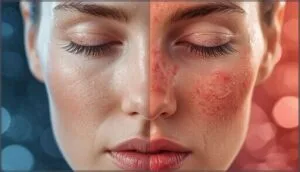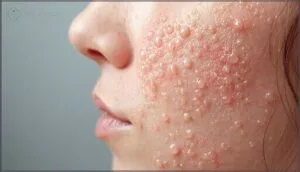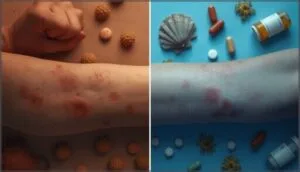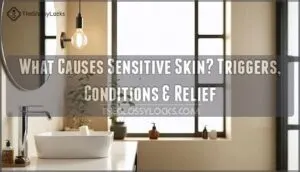This site is supported by our readers. We may earn a commission, at no cost to you, if you purchase through links.
Stress can show itself in unexpected places—sometimes right on your skin. You might notice a flare of eczema after a tough week, or new patches of redness when anxiety lingers.
The mind-skin connection runs deeper than most realize; hormones like cortisol push oil production into overdrive, leaving your skin more reactive and less resilient. Small triggers turn into stubborn breakouts, and even your skin’s natural barrier finds itself struggling to keep up.
Understanding how skin conditions caused by stress develop is the first step to turning things around—helping you reclaim comfort and control, one day at a time.
Table Of Contents
- Key Takeaways
- How Stress Affects Skin Health
- Common Skin Conditions Triggered by Stress
- The Link Between Anxiety and Skin Problems
- What Does a Stress Rash Look Like?
- Environmental and Lifestyle Factors
- When to Seek Medical or Dermatological Help
- Frequently Asked Questions (FAQs)
- Is stress affecting your skin?
- How does stress affect eczema?
- Can stress cause a skin rash?
- How does stress affect your skin and hair?
- Can stress cause rosacea?
- What skin conditions are linked to anxiety?
- Can stress cause permanent skin damage over time?
- How long after stress reduction do symptoms improve?
- Conclusion
Key Takeaways
- Stress triggers measurable skin changes through cortisol-driven oil production, barrier weakening, and inflammation that directly cause or worsen conditions like eczema, psoriasis, rosacea, and acne.
- The mind-skin connection operates as a two-way cycle where psychological distress aggravates skin symptoms while visible skin issues increase anxiety, depression, and social stigma by 14–20%.
- Environmental factors like poor sleep, inadequate nutrition, pollution, and weather changes compound stress-related skin damage by further compromising barrier function and triggering inflammatory responses.
- Professional dermatological and mental health support becomes essential when symptoms persist beyond 48 hours, interfere with daily life, or include severe signs like oozing, fever, or uncontrolled itching.
How Stress Affects Skin Health
Your body’s stress response doesn’t just affect your mind—it directly impacts your skin in measurable, clinical ways. When you’re under pressure, your body releases hormones and triggers reactions that compromise your skin’s health and resilience.
Let’s look at three key mechanisms that explain why stress shows up on your skin.
Stress Hormones and Skin Sensitivity
When stress hits, your body releases cortisol and adrenaline—hormones that don’t just affect your mood. Cortisol triggers excess oil production and weakens your skin barrier, making it harder to retain moisture.
This hormone imbalance disrupts your skin’s neuroendocrine response, increasing stress reactivity and sensitivity. The result? Your skin becomes more vulnerable to irritants, dryness, and breakouts.
Understanding the impact of stress management techniques is essential for mitigating these effects.
Inflammation and Immune Response
Beyond cortisol, chronic stress triggers neuroinflammation by releasing pro-inflammatory cytokines like IL-6 and IL-8 into your skin tissue. Your immune system shifts from protection to immune suppression, reducing infection defense while increasing oxidative stress. Mast cell activation near nerves amplifies this response—studies show stress can boost mast cell degranulation up to 27% in a single day. This unchecked inflammation directly worsens skin conditions like psoriasis and eczema.
Chronic stress also affects the body’s physiological biomarkers, including cortisol levels, which play a key role in the development of various skin conditions.
Impact on Skin’s Barrier Function
Your skin’s protective barrier takes a direct hit when cortisol disrupts epidermal lipids and structural proteins needed for moisture retention. This accelerates collagen breakdown and increases transepidermal water loss, leaving your skin dry and vulnerable.
Studies confirm higher stress scores correlate with worse barrier function—making you more susceptible to irritants, allergens, and infections. Barrier repair ingredients like ceramides become essential during these periods.
Common Skin Conditions Triggered by Stress
Stress doesn’t just affect your mood—it can show up on your skin in very specific ways. From flare-ups of chronic conditions to sudden breakouts, the connection between your mental state and your skin is stronger than many people realize.
Let’s look at the most common skin conditions that stress can trigger or worsen.
Eczema and Dermatitis
When you’re overwhelmed, your body floods with cortisol, which weakens your skin barrier and triggers inflammatory responses. Clinical data shows that 57% of women and 41% of men with eczema name stress as their top flare-up trigger.
You’ll notice increased itching, redness, and dryness during high-pressure periods. Dermatitis management requires addressing both skin conditions and stress levels for effective itch relief.
Psoriasis Flare-Ups
Roughly 8 million Americans live with psoriasis, and overwhelming evidence confirms that psychological strain triggers painful flare-ups. When you’re under pressure, your body’s immune response goes into overdrive, sparking inflammation that manifests as red, scaly patches.
Key psoriasis triggers linked to stress:
- Elevated cortisol disrupting your skin’s natural healing
- Heightened inflammatory processes creating new lesions
- Depression affecting one in three patients, worsening symptoms
Stress management and psychodermatology approaches help break this cycle, offering genuine flare-up prevention alongside standard treatment.
Rosacea Exacerbation
Three-quarters of rosacea patients notice their facial redness and burning intensify when stress levels spike. This connection persists year-round, regardless of whether you’re actively treating your rosacea.
The inflammation triggered by anxiety can reignite symptoms even after long remissions, creating cycles of stinging, papules, and heightened skin sensitivity. Managing stress triggers becomes essential for controlling these unpredictable flare-ups.
Acne and Breakouts
High-stress periods—like exam weeks—push adolescents to develop 23% more severe acne than their calmer peers. When cortisol surges through your system, it doesn’t increase oil directly but amplifies inflammation that turns minor blemishes into painful breakouts.
These hormonal imbalances create predictable patterns: your skin flares during deadlines, then settles once stress eases, affecting both physical health and confidence.
Urticaria (Hives) and Rashes
When urticaria persists beyond six weeks, stress and anxiety often drive the cycle—your body’s HPA axis goes haywire, triggering immune responses that manifest as itchy welts.
This chronic spontaneous urticaria affects both your skin and mental health, since the constant itching fuels more anxiety.
Hive treatment requires addressing both physical symptoms through itch management and emotional triggers, sometimes including allergy testing to rule out other rash causes.
The Link Between Anxiety and Skin Problems
Anxiety and skin problems often feed off each other in ways that can feel impossible to break. When stress triggers itching or visible changes, your emotional response can actually make symptoms worse.
Here’s how anxiety influences skin health and why understanding this connection matters for effective treatment.
Itch-Scratch Cycle and Anxiety
When you scratch an itch, you’re actually feeding a vicious loop that anxiety makes worse. Research shows chronic itch patients with eczema and psoriasis experience markedly higher stress levels, and psychological distress directly aggravates itch perception through your central nervous system.
Consider these cycle breakers for itch management:
- Apply targeted stress-reduction techniques like cognitive behavioral therapy
- Use prescribed anti-itch medications that also reduce anxiety triggers
- Keep nails trimmed short for scratch prevention
- Practice mindfulness to interrupt automatic scratching responses
Breaking this itch-scratch cycle requires addressing both your skin and emotional health simultaneously.
Chronic Itching (Pruritus)
Chronic pruritus—persistent itching lasting weeks or months—affects dermatology patients at alarming rates, with anxiety appearing markedly more often in those experiencing ongoing itch.
Your skin nerves don’t operate in isolation; neurological factors and psychogenic itch patterns mean stress and itching feed each other relentlessly.
Studies show that when biologics reduce chronic itch intensity, anxiety scores drop measurably too, proving that effective itch relief tackles both pruritus causes and your mental well-being.
Emotional Distress and Visible Skin Issues
When your skin condition becomes visible to others, the emotional toll intensifies dramatically. Research shows that adults with atopic dermatitis face a 14–20% higher risk of depression and anxiety compared to those with clear skin.
Social stigma and compromised body image can erode self-esteem, triggering a psychodermatology crisis where stress rash symptoms and mental health struggles reinforce each other—a pattern demanding integrated care addressing both emotional triggers and skin health.
What Does a Stress Rash Look Like?
When stress triggers hives or a rash, you might wonder what you’re actually looking at on your skin. Stress rashes have distinct characteristics that can help you identify them, though they sometimes look similar to allergic reactions.
Let’s break down what to watch for, how to tell stress rashes apart from other skin issues, and where they usually show up on your body.
Typical Appearance and Symptoms
When stress triggers a physical response, you’ll notice raised, red or pink bumps across your face, neck, chest, or arms. These hives often appear suddenly, changing shape and size within hours.
You’ll likely feel intense itching, burning, or tingling sensations. The bumps may merge into larger patches, and pressing them reveals lighter centers—a telltale sign that distinguishes stress rash from other skin irritation.
Differentiating From Allergic Reactions
While both produce hives and itchiness, differentiating stress rash symptoms from allergic reactions matters for proper treatment. Allergic reactions usually occur after exposure to specific triggers—foods, medications, or environmental contacts—and can escalate to anaphylaxis. Stress rash, however, emerges through neuroimmune interactions without allergen exposure, developing gradually during emotional upheaval.
This diagnostic challenge requires examining timing, triggers, and immune response patterns. Skin inflammation from stress won’t respond to allergen avoidance alone.
Common Locations on The Body
Notice how a flare can show up almost anywhere—cheeks flushed with facial rashes, or a sudden wave of neck irritation just beneath your collar. Trunk lesions and abdominal itch reveal how sensitive your middle can be, while limb hives cluster on arms, hands, and even legs.
Stress and skin health are closely tied, making these skin conditions a visible sign of anxiety.
Environmental and Lifestyle Factors
Your environment and daily choices can make a big difference when your skin is under stress. Factors like what you eat, how you sleep, and even the air around you might play a role.
Let’s look at what matters most in your routine and surroundings.
Effects of Poor Sleep and Diet
Ever pulled an all-nighter or indulged in junk food and noticed your face looking dull, dry, or broken out? Disrupted sleep patterns and poor dietary habits chip away at the skin’s barrier, increasing skin inflammation and sensitivity. Nutrient deficiencies make healing sluggish. Over time, these lifestyle changes can worsen chronic skin conditions and anxiety, revealing how stress and skin health intertwine. For lasting improvement, focus on stress management, mental health, and thoughtful psychodermatology strategies.
- Sleep loss amplifies irritation.
- Sugary foods increase breakouts.
- Lack of antioxidants slows recovery.
- Balanced routines foster resilience.
Environmental Triggers (Pollution, Weather)
From city life’s daily grind to shifting seasons, your skin faces constant environmental challenges. Air pollution and sudden weather changes heighten inflammation, aggravating conditions like eczema, psoriasis, and hives—especially if you’re already dealing with stress or anxiety.
Humidity levels play tricks too: dry, cold air weakens your barrier and invites flare-ups, while excess moisture can spark acne or fungal rashes. Environmental factors truly shape skin health and wellness, demanding thoughtful care for lasting dermatological resilience.
When to Seek Medical or Dermatological Help
Sometimes, skin problems need more than just at-home care or patience. If you’re wondering whether it’s time to get professional advice, a few situations stand out.
Here’s what to look for next.
Signs Professional Evaluation is Needed
Is your stress rash refusing to fade, or are severe symptoms—like oozing, fever, or unexplained blisters—throwing you off balance? Chronic conditions and persistent itching tied to anxiety and skin health can chip away at daily life.
If skin infections, emergency referrals, or mental health struggles creep in, it’s time for specialized evaluation—this is the heart of psychodermatology care.
Medical Treatments and Therapies
If your stress rash won’t budge, medical options step in. Antihistamines like Benadryl can calm sudden hives. Persistent eczema? Topical corticosteroids, or in tougher spots, a brief Prednisone course, help.
Severe flare-ups often call for Phototherapy Sessions or targeted Pharmacological Options.
Cognitive Therapy, Mindfulness Techniques, and Biofeedback Training round out care, easing both skin and mind.
Mental Health Support for Chronic Skin Issues
You’re not alone in feeling how skin issues can weigh on your mind—up to 85% of patients say the mental burden is just as real.
Eighty-five percent of people with skin issues say the emotional impact feels just as real as the physical symptoms
Psychodermatology care bridges mental health and skin, using Cognitive Therapy, Mindful Practices, and mental wellness support to break the cycle between stress and anxiety, helping you find real emotional healing by respecting the mind-body connection.
Frequently Asked Questions (FAQs)
Is stress affecting your skin?
Your body sends clear signals when psychological tension takes a toll. Breakouts, unexpected rashes, and persistent itching often point to stress as the underlying culprit affecting your skin’s health and appearance.
How does stress affect eczema?
When you’re under pressure, your body floods with cortisol—this stress hormone weakens your skin barrier and triggers inflammation, making eczema flare-ups more frequent and intense while fueling the relentless itch cycle.
Can stress cause a skin rash?
Yes, emotional tension can trigger hives and rashes—up to 31% of highly stressed individuals develop them.
When your cortisol spikes, inflammation rises, making your skin more reactive and prone to itchy, red welts.
How does stress affect your skin and hair?
When your mind’s under siege, your skin and hair bear the battle scars. Cortisol floods your system, triggering inflammation, oil surges, and weakened barriers—causing breakouts, sensitivity, and hair loss that disrupts your beauty routine completely.
Can stress cause rosacea?
Stress doesn’t directly cause rosacea, but it’s a powerful trigger. About 79% of patients report anxiety worsens their symptoms, with stress-induced cortisol amplifying facial redness, burning, and inflammation—making flare management essential.
What skin conditions are linked to anxiety?
Anxiety disorder commonly affects your skin through acne, eczema, psoriasis, neurodermatitis, and anxiety hives. Cortisol effects trigger skin inflammation and worsen existing conditions.
Psychodermatology recognizes stress and anxiety as significant factors in these skin conditions and anxiety relationships.
Can stress cause permanent skin damage over time?
Chronic stress accelerates collagen breakdown and weakens your skin’s protective barrier, leading to premature aging, persistent inflammation, and oxidative damage. If left unmanaged over months to years, these effects can become permanent.
How long after stress reduction do symptoms improve?
Most acute stress rashes fade within 24 to 48 hours, while chronic conditions like eczema or psoriasis usually show visible relief duration improvements within 1 to 2 weeks of consistent stress management and targeted treatment outcomes.
Conclusion
Your skin is a mirror—it reflects not just light, but the weight you carry inside. When stress stirs inflammation, breakouts, or flare-ups, it’s your body asking for attention.
Recognizing skin conditions caused by stress enables you to respond with both science and self-care. Whether through medical treatment, lifestyle shifts, or mental health support, you can quiet the storm beneath the surface.
Healing begins when you listen—and act with intention.
- https://jamanetwork.com/journals/jamadermatology/fullarticle/479409
- https://pmc.ncbi.nlm.nih.gov/articles/PMC10712576/
- https://jddonline.com/articles/psychosocial-stress-and-mechanisms-of-skin-health-a-comprehensive-update-S1545961621P0062X/
- https://www.healthline.com/health/stress-and-chronic-spontaneous-urticaria
- https://www.pfizer.com/news/articles/eczema_and_stress_what_s_the_link











